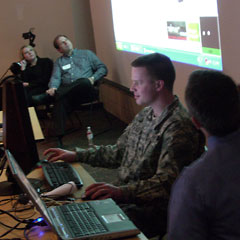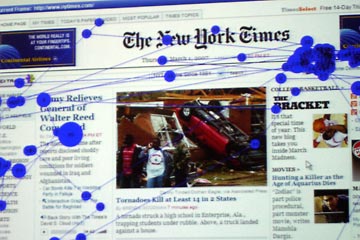
A new sound
It was a few minutes before dawn—about 6:45 a.m.— when I realized that I was hearing something that had been missing for a long time: birds.
I guess the birds were just greeting the dawn, because after about 10 minutes I didn't hear them anymore. Even though spring is officially still three weeks away, it's starting to sound less like winter.
You eyeballin' me?
 A
big part of the appeal of the Web Association's meeting
about web usability tonight was the demo of eye-tracking. It used
to take highly specialized and cumbersome equipment to follow and record
a user's eye movements scanning a website, but it's become much more
user friendly.
A
big part of the appeal of the Web Association's meeting
about web usability tonight was the demo of eye-tracking. It used
to take highly specialized and cumbersome equipment to follow and record
a user's eye movements scanning a website, but it's become much more
user friendly.
David Robins and Aaron Rosenberg from the Kent State University Usability Lab brought their computers and webcam and set up shop at the front of the auditorium.
When they needed a volunteer, Geo, a Tri-C student who came to the meeting right from his Army Reserve meeting, stepped up. After sitting down at the computer it took only a few seconds to calibrate the equipment. Then he was given the task of finding out how to sign up for home delivery of the New York Times on the NYT website.
 As
you can see from this screen capture, Geo had to do a lot of back
and forth scanning before he finally found the link. It's the area at top
right where there are a lot of blue circles.
As
you can see from this screen capture, Geo had to do a lot of back
and forth scanning before he finally found the link. It's the area at top
right where there are a lot of blue circles.
Each circle represents a spot where his gaze paused for a fraction of a second, with larger circles showing longer pauses.
The hardware/software not only shows a live image of the user's eye movements, but records it as a video that can be played back and studied.
What a great way to settle those arguments about how effective a design is!
An interesting sidelight: notice how much time Geo spent with the article about Walter Reed Hospital. It clearly has nothing to do with his task of signing up for home delivery of the Times. I'm guessing that because he's in the military, his interest in the subject was strong and unavoidable. Probably if I did the same test I'd pass right over the article.
More on usability
Let's give the last word on the value of usability testing to Cathy Zapata from Brulant. She's heard—as we all have—from clients who say that they don't need to test because they "know their customers." Yet it's critical to remind them that they are not their customers. Or as Cathy put it, your customers are not you.

